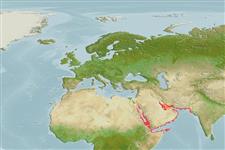Common names from other countries
Environment: milieu / climate zone / depth range / distribution range
Sinh thái học
Biển Cùng sống ở rạn san hô; Mức độ sâu 5 - 50 m (Ref. 89707). Tropical; 29°N - 10°N, 32°E - 68°E (Ref. 5222)
Western Indian Ocean: Red Sea (including Gulf of Suez) and northwestern Indian Ocean to the coast of Pakistan. Specimens examined include those from the Gulf of Oman. Not reported from the Gulf of Aqaba nor from Persian Gulf.
Bộ gần gũi / Khối lượng (Trọng lượng) / Age
Maturity: Lm ? range ? - ? cm
Max length : 38.0 cm TL con đực/không giới tính; (Ref. 89707); common length : 35.0 cm TL con đực/không giới tính; (Ref. 5450)
Các tia vây lưng cứng (tổng cộng) : 11; Các vây lưng mềm (tổng cộng) : 16 - 18; Tia cứng vây hậu môn: 3; Tia mềm vây hậu môn: 8. Body robust, preopercle with moderately enlarged serrae at its angle; upper edge of the operculum almost straight; nostrils subequal or posterior nostril slightly larger. Head and body yellowish gray, with dark orange-red or reddish brown spots except ventrally and posteriorly; dark gray bars running antero-ventrally from the base of the dorsal fin; a dark saddle blotch on the caudal peduncle. Fins generally yellowish brown; median fins with broad yellowish margin posteriorly (Ref. 89707).
Occurs on shallow sandy bottoms near small coral heads; it is not known from well-developed coral reefs (Ref. 5222). Nothing has been published on its biology nor its use in fisheries (Ref. 5222). Sold fresh in local markets (Ref. 5222).
Life cycle and mating behavior
Maturities | Sự tái sinh sản | Spawnings | Egg(s) | Fecundities | Ấu trùng
Heemstra, P.C. and J.E. Randall, 1993. FAO Species Catalogue. Vol. 16. Groupers of the world (family Serranidae, subfamily Epinephelinae). An annotated and illustrated catalogue of the grouper, rockcod, hind, coral grouper and lyretail species known to date. Rome: FAO. FAO Fish. Synop. 125(16):382 p. (Ref. 5222)
IUCN Red List Status (Ref. 130435)
CITES (Ref. 128078)
Not Evaluated
Threat to humans
Harmless
Human uses
Các nghề cá: buôn bán nhỏ
Các công cụ
Special reports
Download XML
Các nguồn internet
Estimates based on models
Preferred temperature (Ref.
115969): 25.4 - 29.4, mean 27.9 (based on 142 cells).
Phylogenetic diversity index (Ref.
82804): PD
50 = 0.5000 [Uniqueness, from 0.5 = low to 2.0 = high].
Bayesian length-weight: a=0.01175 (0.00571 - 0.02419), b=3.04 (2.88 - 3.20), in cm Total Length, based on LWR estimates for this Genus-body shape (Ref.
93245).
Mức dinh dưỡng (Ref.
69278): 3.7 ±0.6 se; based on size and trophs of closest relatives
Thích nghi nhanh (Ref.
120179): Trung bình, thời gian nhân đôi của chủng quần tối thiểu là 1.4 - 4.4 năm (Preliminary K or Fecundity.).
Fishing Vulnerability (Ref.
59153): Low to moderate vulnerability (28 of 100).
